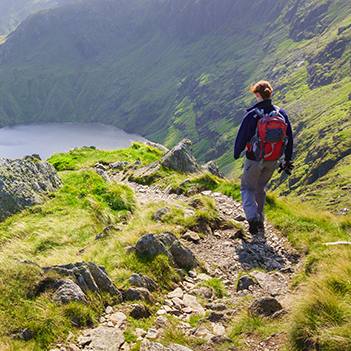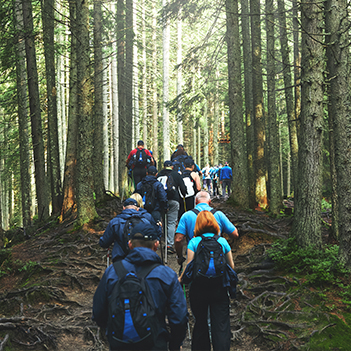A literary guide to Y 100 Sir Fynwy
The annual LDWA Hundred provides not only a stern test of physical and mental resilience, but also a wonderful chance to learn more about a specific part of country. There is landscape, history, geography and culture to explore. In terms of the latter, literature is one central aspect and the route of the Sir Fynwy Hundred and its surrounds are blessed with some outstanding writing that have used the natural environment as their backdrop or inspiration. Here is a guide to some of the best, from times past to the present day.
Celebrating the Black Mountains
In many ways the high-point of the Sir Fynwy 100, the majestic landscape of the Black Mountains has been attracting literary admirers for centuries.
Among the earliest, and most prominent of these is Gerald of Wales whose twelfth century Itinerarium Cambriae (“Journey Through Wales") describes his travels around his beloved homeland while on a recruitment campaign for the Crusades with the Archbishop of Canterbury. The work remains, in the words of modern critics, “… a very valuable historical document, significant for the descriptions – however untrustworthy and inflected by ideology, whimsy, and his unique style…”.
Such a description captures the enduring appeal of Gerald – plenty of intriguing and scholarly observational detail mixed together with local colour and sometimes dubious assertions. His Welsh travelogue shares a number of calling points with those that Sir Fynwy Hundredeers will make including Llanthony Priory, Usk and Abergavenny – albeit it is believed that his actual journey may not have visited the first two of these (suggesting an underuse of self-clips in the twelfth century).
Gerald’s writings continue to spark literary imaginations as evidenced by the 2019 publication of Footnotes by Peter Fiennes. Part travelogue and part literary biography, Fiennes book is based on his own travels recreating the earlier journeys of twelve noted writers - with Gerald joining Charles Dickens, J.B. Priestley and Enid Blyton on the authorial roll-call.
At home in the Blacks
It is not just visitors who have been inspired to write about the Black Mountains, but some of its favourite sons as well – Raymond Williams being chief among them.
Perhaps better known as an academic and influential pioneer in the field of cultural studies, where his works include the seminal Culture and Society, and, The Country and the City, Williams was born a short walk from the Sir Fynwy route at Llanfihangel Crucorney. His birthplace and its surrounds heavily influenced his literary output that includes Border Country and the two-volume People of the Black Mountains.
The former is set in the fictional village of Glynmawr and examines many of the themes Williams explored in his academic pursuits. A son returns from his professional life in London to visit his sick father, a former railway signalman, with the two struggling with their memories of social and personal change told via flashbacks that draw upon the 1926 General Strike and the Great Depression. Originally published in 1960, Border Country was re-published in 2006 as one of the first titles in the Library of Wales series designed to celebrate and preserve some of the nation’s most important writing in English.
People of the Black Mountains is a more experimental work that tells the history of the folk who have lived in its eponymous hills through a series of sequential short stories. The tales start in the Stone Age and tell of the arrival, impact and influence of Neolithic farmers, the Celts, the Romans and Normans amongst others. Based on archaeological evidence, the historical narrative stretches through to the late Medieval period – it was intended to reach modern times but Williams died before he could complete the final volume.
Black in name, bleak in nature
Another celebrated author (and travel writer) to use the Black Mountains as a backdrop is Bruce Chatwin with his bleak tale of human experience, On the Black Hill. The story is told through the lives of twin brothers whose existence is driven by the harsh demands of their upland farm, The Vision, that straddles the Wales-England border. The novel explores a range of social and emotional issues as it tells the stories of the brothers lives and how they have been shaped by the landscape that surrounds them. The book won both the James Tait Black Memorial Prize and Whitbread First Novel of the Year Award and has been adapted for both stage and screen.
The novel uses a mixture of real and fictious place names, with the majority indicating it is based around the border of Herefordshire and Powys just south of Hay on Wye. The Vision is a real farm, referenced on OS Maps, located a few miles north of the Sir Fynwy route as it reaches Llanthony, with (Herefordshire’s) Black Hill a few miles further north on Hatterall Ridge. An alternative theory, however, suggests the Black Hill of the title may be the prominence between Knighton and Clun ((SO326790)), as Chatwin is known to have stayed in the area.
Sheer beauty
The power of the Black Mountains to inspire creativity continues into the present day, as exemplified by the work of one of Wales’ leading contemporary authors, Owen Sheers. Raised in Abergavenny, the town’s distinctive surrounding hills have inspired much of his work, both prose and poetry. Like Raymond Williams before him, Sheers attended King Henry VIII School, which the Sir Fynwy route passes on its way towards the Sugar Loaf, the southernmost of the Black Mountains peaks.
Sheers’ first novel, Resistance, has again used a valley below Hatterall Ridge as the setting. This time the backdrop is the Olchon Valley, crossed by hundredeers en route to Longtown, with its isolation serving at the basis of an alternative history novel set in the latter days of WWII. The novel tells of an encounter between a group of German Wehrmacht soldiers and the women and children who have become the sole occupants of the valley after its men have left to join the British Resistance. Like On the Black Hill, the novel has also been made into a film.
Sheers is also an acclaimed poet, with his work often featuring the natural world, none more so than his 2005 collection Skirrid Hill. Not only does the volume’s title refer to one of Abergavenny’s famed Three Peaks (Ysgyryd Fawr), visible for much of the Sir Fynwy route, but it also features a pair of poems (The Hill Fort, and, Y Gaer) that would seem to be set on the Y Gaer summit passed on the way to Cymyoy. The words of The Hill Fort will hopefully resonant with all hundreedeers:
“… it isn't the number of steps
that will matter
but the depth of their impression.”
Still Black, but even darker
Should crime fiction be more to your literary taste, than the Black Mountains also features in Harry Bingham’s series of DC Fiona Griffiths’ novels. The protagonist is a young Cardiff-based detective whose analytic talents contrast with her limited social skills and a past complicated by mental illness. The second volume of Bingham’s now six-book series, Love Story, With Murders, takes the reader from their usual surrounds of the Welsh capital to a remote cottage near Capel y Finn, once more a little further into the Vale of Ewyas than the Sir Fynwy’s crossing point at Llanthony (a valley that Gerald of Wales describes as “… an arrow-shot broad, encircled on all sides by lofty mountains”). Griffiths’ harrowing journey, in pursuit of clues to solve a series of grisly murders, sees her encounter even more difficulties than will beset even the unluckiest of the Hundredeers.
Gilpin, Wordsworth and the Wye Tour
The finishing straight of the Sir Fynwy Hundred, the Wye Valley, has long attracted visitors and played a key role in the emergence of the concept of the ‘picturesque’. In doing so, it ushered in a new type of tourism in the late eighteenth century that brought with a greater appreciation of the natural landscape.
Beyond its obvious natural beauty, a key reason for Wye Valley’s rise to prominence was the publication of Observations on the River Wye and Several Parts of South Wales by the Reverend William Gilpin. Regarded as the first tour guide to be published in Britain, Gilpin’s 1782 work introduced the ‘Wye Tour’ with visitors taking to boats to view many of the landmarks that feature on the Hundred route - Chepstow Castle, Tintern Abbey, the Kymin and the Piercefield estate among them. Coinciding with the Napoelonic Wars that ruled out travel to Europe for the traditional Grand Tour, Gilpin’s book helped ignite a new fashion for the ‘picturesque’ - which focused attention beyond classical views of beauty to those that included a greater appreciation of the natural landscape.
The Wye Valley popularised by Gilpin attracted an illustrious roll-call of writers, poets and artists, with Samuel Coleridge, J. M. W. Turner and Alfred Tennyson among them. The Romantic heavyweight that is perhaps most associated with the area, however, is William Wordsworth. His poem, Lines Written a Few Miles above Tintern Abbey, was inspired by the scenery that hundredeers will enjoy between Llandogo and Cleddon (if they are there in daylight!) – at more than ninety miles into the great walk hopefully they too can enjoy:
… these steep and lofty cliffs,
That on a wild secluded scene impress
Thoughts of more deep seclusion; and connect
The landscape with the quiet of the sky
Some famous neighbours
Although not quite in the footprint of Sir Fynwy, it seems inappropriate to write about the literature of South Wales’ hills and valleys without mentioning Alexander Cordell and Richard Llellewyn, both of whom have written hugely popular works based in these setting.
Cordell, the pen-name of George Alexander Graber, was a prolific novelist best known for Rape of the Fair Country. Set in the 19th century in the iron-making communities of the Blaenavon and Nantyglo, a few miles to the west of the Hundred route, it tells of growing tensions between ironmasters and workers through the Mortymer family. A prolific writer, some of Cordell’s works do cross paths (or very nearly) with the Sir Fynwy route such as Requiem for a Patriot, a retelling of the story of the Chartist John Frost who went on trial and was sentenced in Monmouth’s Shire Hall.
Richard Llellewyn, meanwhile, is the author of How Green Was My Valley, that tells the story of the Morgan family and their life in a Valleys mining community (based on the village of Gilfach Goch in the Ogmore Valley) in the Victorian era.
Spoilt for choice
So, whether your literary preferences lean towards poetry or prose, distinguishes between classic and contemporary, or, favours either crime or historical fiction, the route of the Sir Fynwy 100, like the walk itself, has plenty to offer you.




